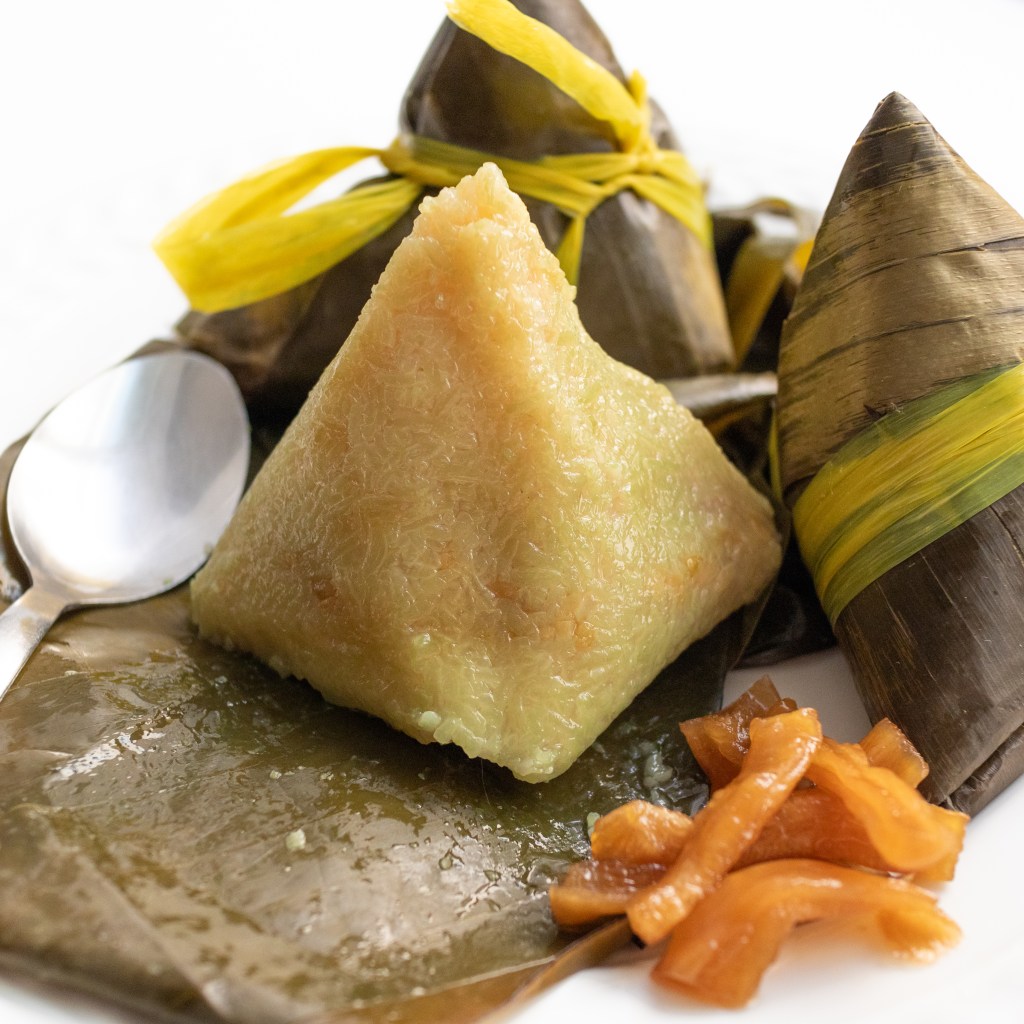If you’re celebrating the Vietnamese Lunar New Year (Tết) and want to impress your family, friends, and even your ancestors, consider making Bánh Ú.

What is Bánh Ú?
Bánh Ú is a traditional Vietnamese glutinous rice cake filled with pork belly and mung beans, wrapped in banana leaves. It’s recognized for its pyramid shape, featuring either a triangular or square base.
Similar to Bánh Tét or Bánh Chưng, Bánh Ú is essentially their single-serving counterpart. The fillings for all three rice cakes are identical; only the shapes differ. Bánh Tét is cylindrical (log-shaped), Bánh Chưng is square, and Bánh Ú is triangular or pyramid-shaped.
While Bánh Tét and Bánh Chưng are great for serving a crowd—sliced and pan-fried for a crispy, golden crust—Bánh Ú is perfect for an individual (or two). Simply unwrap it like a little gift and enjoy with a spoon.

Chinese Zongzi
Bánh Ú closely resembles Zongzi, a traditional Chinese rice cake wrapped in bamboo leaves. While Zongzi is typically wrapped in bamboo leaves, Bánh Ú is always wrapped in banana leaves, imparting a unique aroma and flavor.

Modern Cooking Tips
Traditionally, Bánh Ú is boiled for hours—up to 8! However, with modern tools like a pressure cooker or Instant Pot, you can significantly reduce that time. If you’re pressed for time this Tết, a pressure cooker will be your best friend, allowing you to focus on other Tết preparations, like cleaning your entire house.
In this recipe, we’ll use an 8-quart Instant Pot to cook these delights in just 2.5 hours instead of 8.

What You Will Need
To prepare Bánh Ú at home, gather the following ingredients and kitchen tools:
- Pork Belly: Available at Asian supermarkets. If unavailable, substitute with pork shoulder, which is less fatty.
- Glutinous Rice: Also known as sweet rice. Ensure the package specifies sweet rice or glutinous rice.
- Mung Beans: Look for dried split mung beans, preferably the thin variety found in clear bags.
- Seasonings: For seasoning the pork belly, use shallots, salt, sugar, fish sauce, ground black pepper, and optionally, a pinch of MSG.
- Banana Leaves: Typically found in the freezer section of Asian supermarkets, packaged in large rectangular clear packets.
- Pressure Cooker: An 8-quart Instant Pot is recommended. If you have a smaller one, you may need to cook in batches. Alternatively, use a large stock pot and boil for about 8 hours on the stovetop.
- Strings: Use twine or colorful plastic strings commonly found in the houseware section of Asian supermarkets for tying the rice cakes.

How to Make Bánh Ú
Step 1: Overnight Preparations
Rice: Rinse the dried glutinous rice in a colander until the water runs clear. Transfer to a mixing bowl, cover with water, and let it soak overnight or for at least 4 hours.
Mung Beans: Repeat the same soaking process for the dried mung beans.
Pork: To eliminate surface impurities and odors, rub the pork belly generously with salt. Rinse thoroughly under running water, pat dry, and slice into small chunks. Season with salt, sugar, fish sauce, ground black pepper, shallots, and MSG (if using).
Banana Leaves: Thaw the banana leaves if frozen and cut out 24 sheets of roughly 11×11 inches. Rinse the sheets with hot water to clean and make them more pliable. Dry each sheet with paper towels.
Step 2: Next Day Assembly
Place one banana leaf with the shiny side down, followed by another leaf on top with the shiny side up, ensuring the veins run in opposite directions.
Fold along the diagonal to create a large triangle, then fold again to form a smaller triangle. This will determine the cone shape.


Fold along the diagonal into a large triangle (no need for a perfect triangle).

Fold it once more along the diagonal to form a smaller triangle. The degree of the fold will determine the width of the cone shape.

Open up the layers to form a cone shape. You can place this cone upright in a cup if preferred.
Next, add a layer of rice, followed by mung beans and pork belly.

Then top the pork belly with more mung beans and rice to cover.

Start folding in the sides. You can do this with either 4 sides or 3.

It doesn’t have to be perfect. Fold and tuck as best as you can.

See how imperfect the base is? No big deal.

Flip the imperfect side down to hide it away.

Now, wrap the Bánh Ú with string as securely as possible. The general rule is to place one end of the string (leaving a bit of slack for tying) in one spot by holding it down with your thumb and tuck the string around each corner snugly without breaking the banana leaves.

As shown in the picture, some are wrapped in banana leaves and tied with string, while others are wrapped in foil first, then tied with string. Choose the method that works best for you.
Using foil over the banana leaves is often the easiest option as it quickly holds the leaves in place. Some people prefer using plastic wrap instead of foil, which could have been a simpler choice if I had thought of it at the time—but I didn’t.
Step 3: Pressure Cooking
Add the cakes into the inner pot of the pressure cooker. Fill with water to the maximum fill line. Place a heavy ceramic plate on top to prevent the rice cakes from floating (ceramic is safe in a pressure cooker).
Pressure cook on high for 2 hours and 30 minutes. It will take about 30 minutes to reach pressure.
Once done, allow the pressure cooker to depressurize naturally (about 40 minutes). Once it’s safe to open the lid, remove the ceramic plate and transfer the rice cakes to a wire rack to drain. Pat dry with paper towels if necessary.


Step 4: Serving
Allow the rice cakes to cool to warm or room temperature before enjoying them.
Serve with Vietnamese Fermented Dried Daikon in Fish Sauce (Dưa Món) for an authentic taste of the Vietnamese Lunar New Year.


The top and bottom Bánh Ú were purchased from Thanh Son Tofu in Sacramento. If you’re in the area and don’t feel like making these, pick some up from there—they’re delicious!
Storage & Reheating
If you have leftover Bánh Ú, wrap the cooked rice cakes in plastic wrap to protect them from air exposure. Store them in the fridge for up to one week or in the freezer for up to 8 months.
To reheat, microwave Bánh Ú in 30-second intervals until heated through. If wrapped in foil, be sure to remove it before reheating to avoid any fire hazards—who needs that kind of excitement during the New Year?
Happy cooking, and from my family to yours, chúc mừng năm mới!
Other Tết Recipes
If you enjoyed this recipe, you might like these other traditional dishes for Lunar New Year celebrations:





